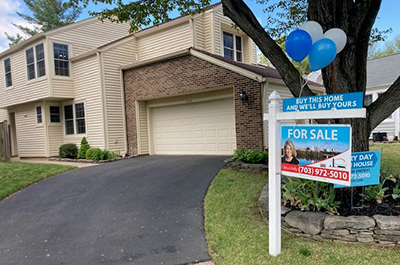
Housing Market Roundup Nov. 5, 2021: Home Prices Ramp Up; Pressure on Margins; More Affordable Homes Available

Another end to the week; another flurry of economic and housing reports. Here’s a quick summary of what’s come across the MBA NewsLink desk:
Radian: Home Prices Continue to Climb at Record Pace
September home prices appreciated nationally at an annualized 17.6 percent from August, marking the sixth consecutive month of record month-over-month rates, according to Radian Home Price Index data released today by Red Bell Real Estate LLC, a Radian Group Inc. company.
The Radian HPI has risen at an annualized rate of 13.9 percent over the nine-month period (January to September), nearly 40-percent higher than the rate of the same period in 2020. Over the past year, the median national estimate is 12.1 percent higher.
“So far, [home prices seem] to be heading in one direction,” said Steve Gaenzler, Radian Senior Vice President of Data and Analytics. “While there are some indications that affordability may be starting to place strain on certain home buyers, the limited supply is a strong support for home price growth.”
Radian said nationally, the median estimated price for single-family and condominium homes rose to $294,488. Since the onset of the pandemic in March 2020, homes across the U.S. have appreciated, on average, by more than $41,000 significantly adding to borrower home equity for mortgage holders.
Radian also reported homes for sale fell from August to September. The percent of homes purchased as a percentage of the number of homes listed for sale stood at 34 percent, nearly double the average monthly absorption rate for the 180 months (15 years) prior to the onset of the COVID-19 pandemic.
The report said all six regional indices recorded higher annual home price appreciation rates than the prior month. The South and West regions recorded the strongest annualized one-month appreciation rates for the third consecutive month (20.4 and 18.3 percent respectively). The Mid-Atlantic region has posted the slowest appreciation rate of all regions (9.9 percent) and was the only region to report a slower appreciation rate in September 2021 compared to the prior month.
Among the 20-largest metropolitan areas of the U.S, more than half (13) recorded faster annual (12-month) price appreciation in September from August.
Fitch Ratings: U.S. Non-Bank Mortgage Originations, Margins to Remain Pressured
Fitch Ratings, New York, said the near-term operating outlook for Fitch-rated U.S. non-bank mortgage companies is negative, given declining origination volumes, continued pressure on gain-on-sale margins and increasing regulatory scrutiny.
Fitch said rising rates, fueled by tapering of Fed asset purchases and home price appreciation from the growing disparity between housing supply and burgeoning demand, are also expected to contribute to lower volumes and margins into 2022. The effect of the environment on ratings, while negative, is differentiated across issuers. Large-scale originators should remain profitable, but a challenging operating environment could force consolidation among smaller companies.
Fitch said margins will remain under pressure, with second-half 2021 originations expected to fall 20%-30% year over year, per the Mortgage Bankers Association. The competitive environment is not expected to abate in the near term, with industry overcapacity stemming from capital raised through IPOs, equity and high-yield debt issuances and robust 2020 earnings.
The report said total delinquencies for single-family mortgage loans were 5.5% at Aug. 21 (as per the MBA National Delinquency Survey), down 275 bps YoY, although 90+ day delinquencies remain three times higher than pre-pandemic levels. The government foreclosure moratorium was lifted in July, and as COVID-19 hardship forbearance programs roll off, a growing number of borrowers are exiting forbearances in a delinquent status, which is expected to increase loss mitigation and foreclosure activity. Higher servicing costs are expected to be manageable, as overall delinquencies and forbearance levels are still low, with stronger housing and employment conditions helping to mitigate losses.
Redfin: Supply of Affordable Homes Posts Record Gain as Mortgage Forbearance Ends
Redfin, Seattle, said the supply of America’s most affordable homes for sale jumped a record 13% year over year in the third quarter as mortgage forbearance programs came to an end, prompting many owners of low-cost homes to put their properties on the market.
The report said supply of homes for sale in the affordable price tier also grew at a record pace, rising 1.6% year over year in the third quarter. Meanwhile, housing supply in the other three segments tumbled, with the number of luxury and expensive homes on the market dropping a record 21.2% and a record 17.9%, respectively.
“The end of forbearance has forced many lower-income Americans to put their homes up for sale and become renters,” said Redfin Chief Economist Daryl Fairweather. “This has caused the number of affordable homes on the market to surge, helping replenish inventory amid an acute housing shortage. It’s a rainstorm after a long drought, but the drought isn’t over yet.”
The report said housing supply in both the most affordable and affordable price tiers remains below historic levels despite the recent record increase. Redfin noted 78,000 active listings in the most affordable tier during the third quarter, compared to more than 100,000 during each of the same periods from 2013 through 2016. In the luxury price tier, there were 158,000 active listings in the third quarter, the fourth-lowest level on record.
“The luxury market remains strong, but is past its pandemic peak,” Fairweather said. “Now that life is somewhat back to normal and travel restrictions have been lifted, many affluent Americans are opting to spend their money on things other than housing.”
